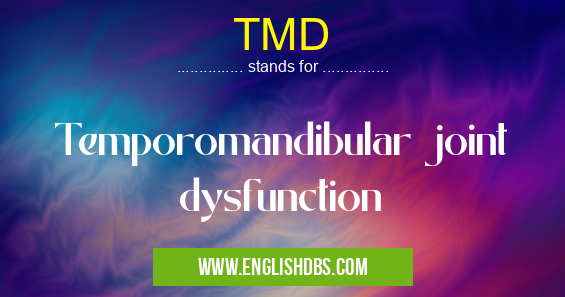What does TMD mean in SURGICAL
TMD stands for Temporomandibular Joint Dysfunction. It is a condition that affects the temporomandibular joint (TMJ), which connects the jawbone to the skull. The TMJ is a complex joint that allows for a wide range of movements, including opening and closing the mouth, chewing, and speaking. When the TMJ is not functioning properly, it can cause a variety of symptoms, including pain, clicking, popping, and difficulty opening the mouth.

TMD meaning in Surgical in Medical
TMD mostly used in an acronym Surgical in Category Medical that means Temporomandibular joint dysfunction
Shorthand: TMD,
Full Form: Temporomandibular joint dysfunction
For more information of "Temporomandibular joint dysfunction", see the section below.
Causes
TMD can be caused by a variety of factors, including:
- Trauma: A blow to the face or jaw can damage the TMJ.
- Overuse: Excessive use of the TMJ, such as grinding or clenching the teeth, can put stress on the joint and lead to TMD.
- Arthritis: Arthritis is a condition that can cause inflammation and damage to the joints, including the TMJ.
- Genetics: Some people are more likely to develop TMD due to their genes.
Symptoms
The symptoms of TMD can vary depending on the severity of the condition. Some common symptoms include:
- Pain: Pain in the face, jaw, or ear. The pain may be constant or intermittent, and it may worsen with certain activities, such as chewing or talking.
- Clicking or popping: Clicking or popping sounds in the TMJ. These sounds may be accompanied by pain or discomfort.
- Difficulty opening the mouth: Difficulty opening the mouth wide, or pain when opening the mouth.
- Lockjaw: The jaw becomes locked in place, making it difficult or impossible to open the mouth.
- Headaches: Headaches that are caused by TMD may be located in the temples, forehead, or back of the head.
- Neck pain: Neck pain that is caused by TMD may be due to the muscles in the neck being overworked to compensate for the TMJ dysfunction.
Diagnosis
TMD is diagnosed based on a physical examination and the patient's symptoms. The doctor may also order imaging tests, such as an X-ray or MRI, to get a better look at the TMJ.
Treatment
The treatment for TMD will depend on the severity of the condition and the underlying cause. Some common treatments include:
- Pain relievers: Over-the-counter pain relievers, such as ibuprofen or acetaminophen, can help to reduce pain and inflammation.
- Muscle relaxants: Muscle relaxants can help to relax the muscles around the TMJ and reduce pain.
- Mouth guards: Mouth guards can help to protect the TMJ from further damage and reduce pain.
- Physical therapy: Physical therapy can help to improve the range of motion in the TMJ and reduce pain.
- Surgery: Surgery may be necessary in severe cases of TMD.
Essential Questions and Answers on Temporomandibular joint dysfunction in "MEDICAL»SURGICAL"
What is TMD?
Temporomandibular joint dysfunction (TMD) is a condition that affects the jaw joint and the muscles that control it. It can cause pain, clicking, and popping sounds when you open and close your mouth.
What are the symptoms of TMD?
The symptoms of TMD can vary depending on the severity of the condition. Some of the most common symptoms include:
- Pain in the jaw joint
- Clicking or popping sounds when you open and close your mouth
- Difficulty opening and closing your mouth
- Locking of the jaw
- Headaches
- Neck pain
- Earaches
What causes TMD?
The exact cause of TMD is not fully understood, but it is thought to be caused by a combination of factors, including:
- Muscle tension
- Joint injury
- Arthritis
- Stress
- Misalignment of the teeth
How is TMD diagnosed?
TMD is diagnosed by a dentist or doctor who will perform a physical examination of your jaw and ask you about your symptoms. They may also order imaging tests, such as an X-ray or MRI, to get a better look at the joint.
How is TMD treated?
The treatment for TMD will depend on the severity of the condition. Some of the most common treatments include:
- Pain relievers
- Muscle relaxants
- Jaw exercises
- Physical therapy
- Splints or mouth guards
- Surgery
Can TMD be prevented?
There is no sure way to prevent TMD, but there are some things you can do to reduce your risk of developing the condition, including:
- Avoid chewing gum or hard candy
- Avoid clenching or grinding your teeth
- Practice good posture
- Manage stress
- See your dentist regularly for checkups
Final Words: TMD is a common condition that can cause a variety of symptoms, including pain, clicking, popping, and difficulty opening the mouth. The treatment for TMD will depend on the severity of the condition and the underlying cause. With proper treatment, most people with TMD can improve their symptoms and return to normal activities.
TMD also stands for: |
|
| All stands for TMD |
